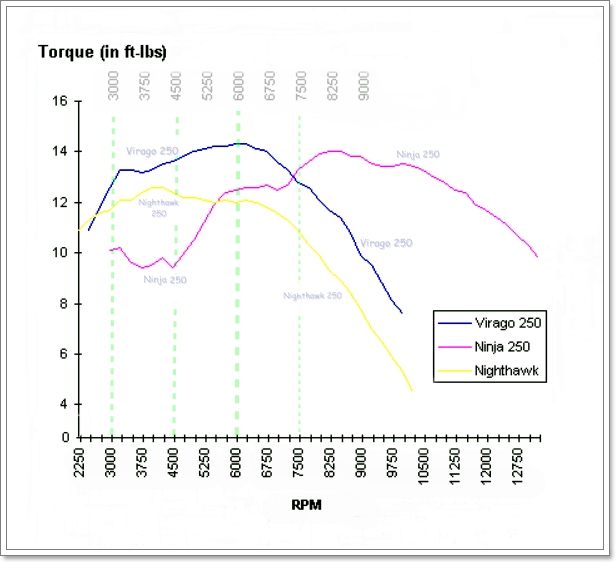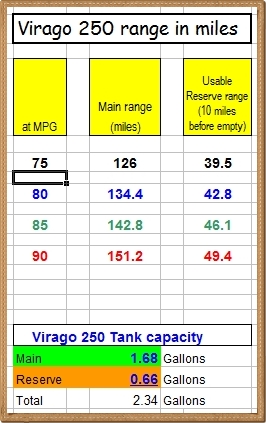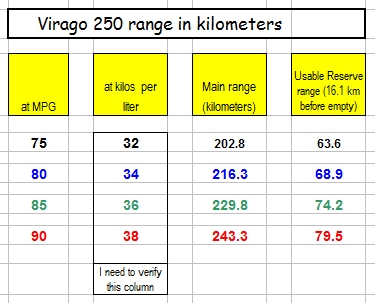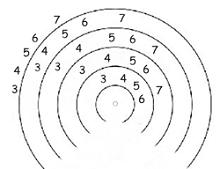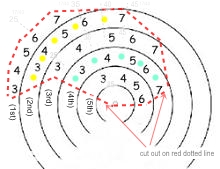Top Ten mods done to my Virago 250:
1) Sprocket change to 17/38. Sprocket change for Virago 250 http://wp.me/p1LWaM-13
2) Weight Reduction The weight of my bike now with a full tank is about 129 kg or 284 lbs.
I have reduced the bike’s weight by about 18 kg or 40 lbs. This reduces the 0-to-60 mph time from 10.8 seconds to 10.2 seconds. http://wp.me/s1LWaM-test
3) Front Fork mods – http://wp.me/p1LWaM-6l Low Cost Front Fork mods – Yamaha Virago 250 – the stock forks may be better than you think
· Fork Oil, changing – Virago 250
· Front Forks, adding 1.625 inch spacer – Virago 250
· Front Forks, torque values – Virago 250
· Fork Brace, measurements to use to find a universal fork brace – Virago 250
· Front Fender, removing – Virago 250 – bad idea to remove – it functions as a light duty fork brace
· Rear fender mounting, two large allen bolts, affects handling, torque value is 43 ft lbs (60 Nm) – Virago 250
· Swing arm pivot bolt, affects handling, torque value is 33 ft lbs (46 Nm) – Virago 250
· Front Forks, springs have two stages – first 1.3 inches is softer – Virago 250
4) Removing chrome head covers on Virago 250 http://wp.me/P1LWaM-jp (top of post, item #5)
5) Improve seating position – add low bars, move seat up 2″, move pegs back 12″
6) Partially expose front sprocket by removing lower part of front sprocket cover.
Advantages of this mod:
1) You can remove the front sprocket or chain without having to remove the front sprocket cover.
2) You can polish the front sprocket and you can keep that area clean. On the bikes that I have owned, that area always has lots of dirt and grease.
3) You get the more mechanical “look” of having an exposed front sprocket, but with some safety since the top part is retained.

I do not recommend this mod as it reduces safety. (If you do it anyway, make sure your chain is in excellent condition and you always wear boots when you ride.)
7) Exposed Voltage Regulator mod for Virago 250 – The “delete left side plastic cover and expose voltage regulator mod.” http://wp.me/P1LWaM-mX (bottom of post)
The voltage regulator runs too hot on some Virago 250s. Basically, mine stays cool if the bike is moving, but gets too hot in stop-and-go traffic or idling.
8) Polished engine and other parts. http://wp.me/p1LWaM-6w

————————————
17/38 sprockets made my Virago 250 faster – higher gearing is not always slower
I just changed (from 17/40) to 17/38 sprockets and drove it to work today with 17/38 for the first time.
As expected, it ”moves up” the speed range for each gear. If you used to go 35 to 50 mph in 4th gear, for example, now you would go 40 to 55 mph. A lot of my commute is 50 mph and hilly, so I was in 4th gear a lot where I used to be in 5th gear. Fourth gear is more comfortable than before at 50 to 55 mph – 5th gear is less comfortable at 50 to 55 mph. Fifth does not climb hills as easily as before.
So basically with 17/38 you stay in lower gears than before and use 5th more for highway use.
In my opinion, 17/38 is the proper stock setup, and 17/40 is good if your carry a passenger, have heavy accessories, or your engine is not running at it’s best.
Not expected – Here is what I found out that I did not expect:
17/38 makes the Virago 250 slower faster
It would be easy to think that higher gearing (17/38) would result in slower acceleration – it does not, since you are usually in a lower gear. Since I was driving in lower gears, the bike felt like it had more acceleration today – it felt like it had more horsepower. I was driving in lower gears than normal, revving the engine more, and driving harder than normal. I got 71.7 mpg the first day (includes some test rides) and 77.2 mpg the second day (my recent average was 79.1 mpg)
.
.
With 17/38 sprockets, 5th gear on the Virago 250 is most usable above 60 mph.
Miles per hour
The Virago 250 greatest torque (between 4500 and 6200 rpm) is this road speed (indicated) in 5th gear:
17/38/130/stock front tire 59 to 81.1 mph
17/38/130/larger front tire 56.4 to 77.6 mph
17/38/140/stock front tire 60.9 to 83.7 mph
17/38/140/larger front tire 58.3 to 80.1 mph
Kilometres per hour
The Virago 250 greatest torque (between 4500 and 6200 rpm) is this road speed (indicated) in 5th gear:
17/38/130/stock front tire 95 to 130.5 kph
17/38/130/larger front tire 90.8 to 124.9 kph
17/38/140/stock front tire 98 to 134.7 kph
17/38/140/larger front tire 93.8 to 128.9 kph
[stock front tire 3.00×18 — “larger” front tire 100/90-18]
.
.
That ↑ was the good news.
Now here is the bad news.
17/38 works so well because you can be in a lower gear – except over 65 to 70 – when you are in top gear. Fifth gear does not climb hills as easily as before and strong headwinds affect the bike more – this is expected, but is still a downside of 17/38 – “less power” over 65 to 70 mph (because you can be only in 5th gear).
Fifth gear with 17/40 is a little stronger that 17/38. A six-speed transmission would be cool – on the highway, you could choose to travel in either 5th or 6th gear – depending on the wind, hills, and other conditions.
For me, with 17/38 I have more power less than 65 mph (because I can be in a lower gear) and less power over 65 mph (5th gear).
The Virago 250 is still very good on the highway for a 250cc bike – and it has a great midrange torque for a 250.
Update August 5, 2013 – This morning there was a strong headwind coming to work. Now that I have a 38 tooth rear sprocket, in 5th gear, it was bogging – reminding me of my CB160. When I got to work, I kept thinking that I should have gotten a 39 tooth rear sprocket instead…………..
——————-

![Sunstar[divider] steel 38T Virago 250 rear sprocket $31.46 shipped step 1 (lumin wild) - Copy--](https://virago250street.wordpress.com/wp-content/uploads/2013/06/sunstardivider-steel-38t-virago-250-rear-sprocket-31-46-shipped-step-1-lumin-wild-copy-e1371854785883.jpg?w=640)

